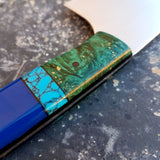








NORA #1223 - Blue | Green Nakiri
$ 335.00
KNIFE HIGHLIGHTS
- Blade Type: Nakiri
- Blade Length: 6.5 Inches
- Total Length: 11.75 Inches
- Handle Style: Western | Right or Left Hand Use
- Steel: AEB-L Stainless Steel
- Handle Materials: Stabilized & Dyed Box Elder Burl Wood, Reconstituted Turquoise Stone, Black G10 liners & spacer, acrylic based resin (blue), Black Micarta Pins
- Rockwell Hardness: 62 HRC
- Grind Type: Full Flat
- Weight: 8.7 oz.
- This Blade is Ground...
- Thin for Performance (best performance but delicate!)
- Thick for Durability (tough, built to last for heavy wear-n-tear, this is where most production knives land i.e. Wustof, Shun, etc.)
- >>> Mid-Range (Thinner than most production knives but kept slightly thicker for overall durability)
- This Knife Feels...
- >>>Heavy in Hand (hefty, durable)
- Light (nimble, maneuverable)
- Not too heavy, not too light (Switzerland, mid-range)
GENERAL USES OF THIS KNIFE
NAKIRI
The Nakiri knife is a Japanese style knife that is specifically designed to excel at cutting and prepping vegetables and greens. These blades are very thin and literally fall through food. Because of the thinness, these blades should not be used for cutting through any type of bone or harder objects but you would be surprised at the versatility of the Nakiri. We find we use ours for a wide array of tasks in the kitchen - everything from protein prep to bread.
The blade height is just over 2 inches which is larger than many other Nakiri's but we find it helps keep your knuckles off the board and it works well with many larger vegetables.
STEEL INFORMATION:
AEB-L STAINLESS STEEL
This knife blade is composed of AEB-L stainless steel which is a high-quality Swedish metal, originally developed for razor blades. Recently, steel suppliers have made this steel available in thicker sheets and it has proven to be an excellent adaptation for the cutlery industry.
AEB-L has a beautiful balance of carbon and chromium and, with proper heat treatment, this steel produces both a very fine edge as well as excellent toughness and edge stability. The fine grain structure also makes this steel very easy to sharpen. We believe it is one of the finest stainless steels available on the market today for use with kitchen knives.
As a side note, there are two things we like to mention about this steel:
1.) This steel responds beautifully to honing and if the knife is honed regularly it should need infrequent sharpening.
2.) AEB-L is a stainless steel but just barely. The concept of stainless steel is actually misleading because every steel is, at some level, reactive to water and other elements.
The higher carbon content in this stainless is what allows it to get a fine edge and higher hardness than other stainless steels but it also has a tendency to sometimes form very fine rust spots on the blade. If this happens, these are easily removed with a green or red scotch brite pad and usually the rough end of a kitchen sponge will also do the trick. Take extra care to remove an excess wetness that remain on this blade. Drip drying is not recommended.
HANDLE DESIGN & MATERIALS:
Every one of our knives is handmade, unique and numbered. This NORA nakiri has a colorful mix of materials. Closest to the blade edge is a stabilized box elder burl wood in an emerald green hue. The lower half of the knife is a royal blue acrylic based resin and in the middle is a reconstituted turquoise stone. Black G10 serves as both spacer material and a liner and the pins coordinate in black micarta.
Wood stabilization is an added feature that we offer with our knives. Wood that is stabilized has been injected with a clear acrylic resin under a vacuum process. Stabilization helps to minimize any cracking, warping, shrinkage and/or expanding of the material. Stabilized wood will absorb little to no water and is generally impervious to oils. The process helps to ensure your knife has a long lifespan in the kitchen.
